Silicon carbide
monocrystal
| |
| Names | |
|---|---|
| Preferred IUPAC name
Silicon carbide | |
| Other names
Carborundum
Moissanite | |
| Identifiers | |
3D model (
JSmol ) |
|
| ChEBI | |
| ChemSpider | |
ECHA InfoCard
|
100.006.357 |
| EC Number |
|
| 13642 | |
| MeSH | Silicon+carbide |
PubChem CID
|
|
RTECS number
|
|
| UNII | |
CompTox Dashboard (EPA)
|
|
| |
| |
| Properties | |
| SiC | |
| Molar mass | 40.096 g/mol |
| Appearance | Yellow to green to bluish-black, iridescent crystals[1] |
| Density | 3.16 g⋅cm-3 (hex.)[2] |
| Melting point | 2,830 °C (5,130 °F; 3,100 K)[2] (decomposes) |
| Solubility | Insoluble in water, soluble in molten alkalis and molten iron[3] |
| Electron mobility | ~900 cm2/(V⋅s) (all polytypes) |
| −12.8 × 10−6 cm3/mol[4] | |
Refractive index (nD)
|
2.55 (infrared; all polytypes)[5] |
| Hazards | |
| GHS labelling:fibres[6] | |

| |
| Danger | |
| H350i | |
| P201, P202, P260, P261, P264, P270, P271, P280, P281, P302+P352, P304+P340, P305+P351+P338, P308+P313, P312, P314, P321, P332+P313, P337+P313, P362, P403+P233, P405, P501 | |
| NFPA 704 (fire diamond) | |
| NIOSH (US health exposure limits): | |
PEL (Permissible)
|
TWA 15 mg/m3 (total) TWA 5 mg/m3 (resp)[1] |
REL (Recommended)
|
TWA 10 mg/m3 (total) TWA 5 mg/m3 (resp)[1] |
IDLH (Immediate danger) |
N.D.[1] |
Except where otherwise noted, data are given for materials in their standard state (at 25 °C [77 °F], 100 kPa).
| |
Silicon carbide (SiC), also known as carborundum (
Electronic applications of silicon carbide such as
Natural occurrence

Naturally occurring moissanite is found in only minute quantities in certain types of meteorite, corundum deposits, and kimberlite. Virtually all the silicon carbide sold in the world, including moissanite jewels, is synthetic.
Natural moissanite was first found in 1893 as a small component of the
While rare on Earth, silicon carbide is remarkably common in space. It is a common form of
History
Early experiments
Non-systematic, less-recognized and often unverified syntheses of silicon carbide include:
- César-Mansuète Despretz's passing an electric current through a carbon rod embedded in sand (1849)
- Robert Sydney Marsden's dissolution of silica in molten silver in a graphite crucible (1881)
- Paul Schuetzenberger's heating of a mixture of silicon and silica in a graphite crucible (1881)
- Albert Colson's heating of silicon under a stream of ethylene (1882).[10]
Wide-scale production
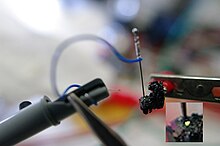
Wide-scale production is credited to Edward Goodrich Acheson in 1891.[11] Acheson was attempting to prepare artificial diamonds when he heated a mixture of clay (aluminium silicate) and powdered coke (carbon) in an iron bowl. He called the blue crystals that formed carborundum, believing it to be a new compound of carbon and aluminium, similar to corundum. Moissan also synthesized SiC by several routes, including dissolution of carbon in molten silicon, melting a mixture of calcium carbide and silica, and by reducing silica with carbon in an electric furnace.
Acheson patented the method for making silicon carbide powder on February 28, 1893.[12] Acheson also developed the electric batch furnace by which SiC is still made today and formed the Carborundum Company to manufacture bulk SiC, initially for use as an abrasive.[13] In 1900 the company settled with the Electric Smelting and Aluminum Company when a judge's decision gave "priority broadly" to its founders "for reducing ores and other substances by the incandescent method".[14]
The first use of SiC was as an abrasive. This was followed by electronic applications. In the beginning of the 20th century, silicon carbide was used as a detector in the first radios.
Production


Because natural moissanite is extremely scarce, most silicon carbide is synthetic. Silicon carbide is used as an abrasive, as well as a
The material formed in the Acheson furnace varies in purity, according to its distance from the graphite resistor heat source. Colorless, pale yellow and green crystals have the highest purity and are found closest to the resistor. The color changes to blue and black at greater distance from the resistor, and these darker crystals are less pure. Nitrogen and aluminium are common impurities, and they affect the electrical conductivity of SiC.[19]
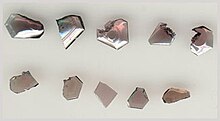
Pure silicon carbide can be made by the
A modified Lely process involving induction heating in graphite crucibles yields even larger single crystals of 4 inches (10 cm) in diameter, having a section 81 times larger compared to the conventional Lely process.[22]
Cubic SiC is usually grown by the more expensive process of chemical vapor deposition (CVD) of silane, hydrogen and nitrogen.
This article may be confusing or unclear to readers. (April 2024) |
[19][23] Homoepitaxial and heteroepitaxial SiC layers can be grown employing both gas and liquid phase approaches.[24]
To form complexly shaped SiC,
SiC can also be made into wafers by cutting a single crystal either using a diamond wire saw or by using a laser. SiC is a useful semiconductor used in power electronics.[31]
Structure and properties
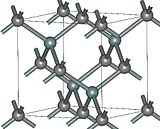 |
 |
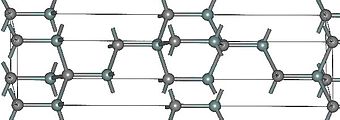 |
| (β)3C-SiC | 4H-SiC | (α)6H-SiC |

Silicon carbide exists in about 250 crystalline forms.
Alpha silicon carbide (α-SiC) is the most commonly encountered
| Polytype | 3C (β) | 4H | 6H (α) |
|---|---|---|---|
| Crystal structure | Zinc blende (cubic) | Hexagonal | Hexagonal |
| Space group | T2d-F43m | C46v-P63mc | C46v-P63mc |
| Pearson symbol | cF8 | hP8 | hP12 |
| Lattice constants (Å) | 4.3596 | 3.0730; 10.053 | 3.0810; 15.12 |
| Density (g/cm3) | 3.21 | 3.21 | 3.21 |
Bandgap (eV)
|
2.36 | 3.23 | 3.05 |
| Bulk modulus (GPa) | 250 | 220 | 220 |
| for temp. dependence) | 320 | 348 | 325 |
| Thermal Expansion Coefficient (10−6 K−1) @300 K (see [38] for temp. dependence) |
-- | 2.28 (⊥ c); 2.49 (∥ c) | 2.25 |
Pure SiC is colorless. The brown to black color of the industrial product results from iron impurities.[39] The rainbow-like luster of the crystals is due to the thin-film interference of a passivation layer of silicon dioxide that forms on the surface.
The high sublimation temperature of SiC (approximately 2700 °C) makes it useful for
Electrical conductivity
Silicon carbide is a semiconductor, which can be doped n-type by nitrogen or phosphorus and p-type by beryllium, boron, aluminium, or gallium.[5] Metallic conductivity has been achieved by heavy doping with boron, aluminium or nitrogen.
Uses
Abrasive and cutting tools

In the arts, silicon carbide is a popular abrasive in modern
In 1982 an exceptionally strong composite of aluminium oxide and silicon carbide whiskers was discovered. Development of this laboratory-produced composite to a commercial product took only three years. In 1985, the first commercial cutting tools made from this alumina and silicon carbide whisker-reinforced composite were introduced into the market.[44]
Structural material

In the 1980s and 1990s, silicon carbide was studied in several research programs for high-temperature gas turbines in Europe, Japan and the United States. The components were intended to replace nickel superalloy turbine blades or nozzle vanes.[45] However, none of these projects resulted in a production quantity, mainly because of its low impact resistance and its low fracture toughness.[46]
Like other hard ceramics (namely alumina and
Silicon carbide is used as a support and shelving material in high temperature kilns such as for firing ceramics, glass fusing, or glass casting. SiC kiln shelves are considerably lighter and more durable than traditional alumina shelves.[49]
In December 2015, infusion of silicon carbide nano-particles in molten magnesium was mentioned as a way to produce a new strong and plastic alloy suitable for use in aeronautics, aerospace, automobile and micro-electronics.[50]
Automobile parts
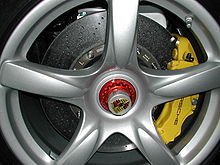
Silicon-infiltrated
Foundry crucibles
SiC is used in crucibles for holding melting metal in small and large foundry applications.[55][56]
Electric systems
The earliest electrical application of SiC was as a
It was recognized early on[
Electronic circuit elements
Silicon carbide was the first commercially important semiconductor material. A crystal radio "carborundum" (synthetic silicon carbide) detector diode was patented by Henry Harrison Chase Dunwoody in 1906. It found much early use in shipboard receivers.
Power electronic devices
In 1993 the silicon carbide was considered a
A major problem for SiC commercialization has been the elimination of defects: edge dislocations, screw dislocations (both hollow and closed core), triangular defects and basal plane dislocations.[59] As a result, devices made of SiC crystals initially displayed poor reverse blocking performance, though researchers have been tentatively finding solutions to improve the breakdown performance.[60] Apart from crystal quality, problems with the interface of SiC with silicon dioxide have hampered the development of SiC-based power MOSFETs and insulated-gate bipolar transistors. Although the mechanism is still unclear, nitriding has dramatically reduced the defects causing the interface problems.[61]
In 2008, the first commercial JFETs rated at 1200 V were introduced to the market,[62] followed in 2011 by the first commercial MOSFETs rated at 1200 V. JFETs are now available rated 650 V to 1700 V with resistance as low as 25 mΩ. Beside SiC switches and SiC Schottky diodes (also Schottky barrier diode, SBD) in the popular TO-247 and TO-220 packages, companies started even earlier to implement the bare chips into their power electronic modules.
SiC SBD diodes found wide market spread being used in
- Gate drive: SiC devices often require gate drive voltage levels that are different from their silicon counterparts and may be even unsymmetric, for example, +20 V and −5 V.[64]
- Packaging: SiC chips may have a higher power density than silicon power devices and are able to handle higher temperatures exceeding the silicon limit of 150 °C. New die attach technologies such as sintering are required to efficiently get the heat out of the devices and ensure a reliable interconnection.[65]
Beginning with Tesla Model 3 the inverters in the drive unit use 24 pairs of silicon carbide (SiC) MOSFET chips rated for 650 volts each. Silicon carbide in this instance gave Tesla a significant advantage over chips made of silicon in terms of size and weight. A number of automobile manufacturers are planning to incorporate silicon carbide into power electronic devices in their products. A significant increase in production of silicon carbide is projected, beginning with a large plant opened 2022 by Wolfspeed in upstate New York.[66][67]
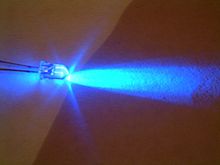
LEDs
The phenomenon of
Carbide LED production soon stopped when a different material, gallium nitride, showed 10–100 times brighter emission. This difference in efficiency is due to the unfavorable indirect bandgap of SiC, whereas GaN has a direct bandgap which favors light emission. However, SiC is still one of the important LED components: It is a popular substrate for growing GaN devices, and it also serves as a heat spreader in high-power LEDs.[69]
Astronomy
The low thermal expansion coefficient,
Thin-filament pyrometry

Silicon carbide fibers are used to measure gas temperatures in an optical technique called thin-filament pyrometry. It involves the placement of a thin filament in a hot gas stream. Radiative emissions from the filament can be correlated with filament temperature. Filaments are SiC fibers with a diameter of 15 micrometers, about one fifth that of a human hair. Because the fibers are so thin, they do little to disturb the flame and their temperature remains close to that of the local gas. Temperatures of about 800–2500 K can be measured.[72][73]
Heating elements
References to silicon carbide heating elements exist from the early 20th century when they were produced by Acheson's Carborundum Co. in the U.S. and EKL in Berlin. Silicon carbide offered increased
Heat shielding
The outer thermal protection layer of NASA's LOFTID inflatable heat shield incorporates a woven ceramic made from silicon carbide, with fiber of such small diameter that it can be bundled and spun into a yarn.[75]
Nuclear fuel particles and cladding
Silicon carbide is an important material in
Silicon carbide
Jewelry

As a
Steel production

Silicon carbide, dissolved in a
Catalyst support
The natural resistance to oxidation exhibited by silicon carbide, as well as the discovery of new ways to synthesize the cubic β-SiC form, with its larger surface area, has led to significant interest in its use as a heterogeneous catalyst support. This form has already been employed as a catalyst support for the oxidation of hydrocarbons, such as n-butane, to maleic anhydride.[83][84]
Carborundum printmaking
Silicon carbide is used in
Carborundum grit is also used in stone Lithography. Its uniform particle size allows it to be used to "Grain" a stone which removes the previous image. In a similar process to sanding, coarser grit Carborundum is applied to the stone and worked with a Levigator, typically a round plate eccentric on a perpendicular shaft, then gradually finer and finer grit is applied until the stone is clean. This creates a grease sensitive surface.[85]
Graphene production
Silicon carbide can be used in the production of graphene because of its chemical properties that promote the production of graphene on the surface of SiC nanostructures.
When it comes to its production, silicon is used primarily as a substrate to grow the graphene. But there are actually several methods that can be used to grow the graphene on the silicon carbide. The confinement controlled sublimation (CCS) growth method consists of a SiC chip that is heated under vacuum with graphite. Then the vacuum is released very gradually to control the growth of graphene. This method yields the highest quality graphene layers. But other methods have been reported to yield the same product as well.
Another way of growing graphene would be thermally decomposing SiC at a high temperature within a vacuum.[86] But this method turns out to yield graphene layers that contain smaller grains within the layers.[87] So there have been efforts to improve the quality and yield of graphene. One such method is to perform ex situ graphitization of silicon terminated SiC in an atmosphere consisting of argon. This method has proved to yield layers of graphene with larger domain sizes than the layer that would be attainable via other methods. This new method can be very viable to make higher quality graphene for a multitude of technological applications.
When it comes to understanding how or when to use these methods of graphene production, most of them mainly produce or grow this graphene on the SiC within a growth enabling environment. It is utilized most often at rather higher temperatures (such as 1300 °C) because of SiC thermal properties.[88] However, there have been certain procedures that have been performed and studied that could potentially yield methods that use lower temperatures to help manufacture graphene. More specifically this different approach to graphene growth has been observed to produce graphene within a temperature environment of around 750 °C. This method entails the combination of certain methods like chemical vapor deposition (CVD) and surface segregation. And when it comes to the substrate, the procedure would consist of coating a SiC substrate with thin films of a transition metal. And after the rapid heat treating of this substance, the carbon atoms would then become more abundant at the surface interface of the transition metal film which would then yield graphene. And this process was found to yield graphene layers that were more continuous throughout the substrate surface.[89]
Quantum physics
Silicon carbide can host point defects in the crystal lattice which are known as
One well known point defect in silicon carbide is the divacancy which has a similar electronic structure as the nitrogen-vacancy center in diamond. In 4H-SiC, the divacancy has four different configurations which correspond to four zero-phonon lines (ZPL). These ZPL values are written using the notation VSi-VC and the unit eV: hh(1.095), kk(1.096), kh(1.119), and hk(1.150).[93]
Fishing rod guides
Silicon carbide is used in the manufacturing of fishing guides because of its durability and wear resistance.[94] Silicon Carbide rings are fit into a guide frame, typically made from stainless steel or titanium which keep the line from touching the rod blank. The rings provide a low friction surface which improves casting distance while providing adequate hardness that prevents abrasion from braided fishing line.[95]
Pottery glazes
Silicon carbide is used as a raw ingredient in some glazes applied to ceramics. At high temperatures it can reduce metal oxides forming silica and carbon dioxide. This can be used to make the glaze foam and crater due to the evolved carbon dioxide gas, or to reduce the colorant oxides and achieve colors such as copper reds otherwise only possible in a fuel powered reduction firing in an electric kiln.[96]
See also
References
- ^ a b c d NIOSH Pocket Guide to Chemical Hazards. "#0555". National Institute for Occupational Safety and Health (NIOSH).
- ^ ISBN 1-4398-5511-0.
- ^ Pubchem. "Silicon carbide". pubchem.ncbi.nlm.nih.gov. Retrieved 2018-11-27.
- ISBN 1-4398-5511-0.
- ^ a b c "Properties of Silicon Carbide (SiC)". Ioffe Institute. Retrieved 2009-06-06.
- ^ "C&L Inventory". echa.europa.eu. Retrieved 12 December 2021.
- Comptes rendus. 139: 773–86.
- S2CID 128600868.
- ^ Kelly, Jim. "The Astrophysical Nature of Silicon Carbide". University College London. Archived from the original on May 4, 2017. Retrieved 2009-06-06.
- ISBN 978-0-412-54060-8.
- ^ Encyclopædia Britannica, eb.com
- ^ Acheson, G. (1893) U.S. patent 492,767 "Production of artificial crystalline carbonaceous material"
- ^ "The Manufacture of Carborundum- a New Industry". Scientific American. April 7, 1894. Archived from the original on January 23, 2009. Retrieved 2009-06-06.
- . Retrieved 2007-10-28.
- ^ Dunwoody, Henry H.C. (1906) U.S. patent 837,616 Wireless telegraph system (silicon carbide detector)
- ^ Hart, Jeffrey A.; Stefanie Ann Lenway; Thomas Murtha. "A History of Electroluminescent Displays". Archived from the original on 2012-04-30. Retrieved 2005-06-21.
- S2CID 135784055.
- .
- ^ ISBN 978-0-85296-870-3.
- ^ Lely, Jan Anthony (1955). "Darstellung von Einkristallen von Silicium Carbid und Beherrschung von Art und Menge der eingebauten Verunreinigungen". Berichte der Deutschen Keramischen Gesellschaft. 32: 229–236.
- ^ Lely SiC Wafers. Nitride-crystals.com. Retrieved on 2013-05-04.
- ^ Ohtani, N.; et al. (2001). Nippon Steel Technical Report no. 84 : Large high-quality silicon carbide substrates (PDF). Archived from the original (PDF) on 2010-12-17.
- ISBN 978-3-540-00367-0.
- ISBN 978-981-256-835-9.
- ^ AM of Ceramics from Preceramic Polymers Published in Additive Manufacturing 2019, vol. 27 pp 80–90
- ^ Europe Makes Ceramics Archived 2020-08-07 at the Wayback Machine Preceramics
- ^ ISBN 978-0-12-752160-2.
- S2CID 97161599.
- S2CID 135586321.
- .
- ^ "KABRA|DISCO Corporation".
- ISBN 978-1-86094-624-0.
- ^ Additive Manufacturing of Ceramics from Preceramic Polymers Published in Additive Manufacturing 2019, vol. 27 pp 80-90
- doi:10.1063/1.358463.
- ^ PMID 27878021.
- ^ Silicon Carbide. Thermal properties. Ioffe Institute Semiconductors Database.
- S2CID 139945430.
- ^ S2CID 267488637.
- ^ "Adept Armor - Silicon Carbide". ADEPT. 6 December 2022. Retrieved 21 March 2023.
- ^ .
- PMID 27878022.
- PMID 27878018.
- ^ Fuster, Marco A. (1997). "Skateboard grip tape", U.S. patent 5,622,759.
- OCLC 58542120.
- ^ "Production of Silicon Carbide". siliconcarbide.net.
- ^ "Ceramics for turbine engines". unipass.com. Archived from the original on 2009-04-06. Retrieved 2009-06-06.
- ^ "Dragon Skin – Most Protective Body Armor – Lightweight". Future Firepower. Archived from the original on 2012-02-17. Retrieved 2009-06-06.
- S2CID 94096447.
- ^ "Silicon Carbide". Ceramic Arts Daily. Archived from the original on 2012-01-26. Retrieved 2012-02-09.
- ^ "UCLA researchers create exceptionally strong and lightweight new metal". UCLA.
- ^ "Top 10 Fast Cars". topmost10.com. Archived from the original on 2009-03-26. Retrieved 2009-06-06.
- S2CID 136537033.
- ^ "SiC Lubrication". Cerma.
- .
- ISBN 978-3-527-62906-0.
- ISBN 978-0-08-053187-8.
- ISBN 978-0-8493-1889-4.
- ISBN 978-0-7506-4059-6.
- .
- S2CID 4328365.
- S2CID 95074081.
- ^ "At 1200 V and 45 milliohms, SemiSouth introduces the industry's lowest resistance SiC power transistor for efficient power management". Reuters (Press release). 5 May 2011. Archived from the original on 15 March 2016.
- ^ "Cree launches industry's first commercial silicon carbide power MOSFET; destined to replace silicon devices in high-voltage (≥ 1200 V) power electronics" (Press release). Cree. 17 January 2011. Archived from the original on 26 November 2016. Retrieved 11 September 2015.
- ISBN 978-3-7315-0083-4.
- ^ Horio, Masafumi; Iizuka, Yuji; Ikeda, Yoshinari (2012). "Packaging Technologies for SiC Power Modules" (PDF). Fuji Electric Review. 58 (2): 75–78.
- SiCMOSFETs
- ^ Amos Zeeberg (May 16, 2022). "What's Down the Road for Silicon?: Meet the new materials overpowering the electric economy". The New York Times. Retrieved May 17, 2022.
- ^ Klipstein, Don. "Yellow SiC LED". Retrieved 6 June 2009.
- ^ ISBN 978-0-12-752156-5.
- ^ "The Largest Telescope Mirror Ever Put into Space". European Space Agency. 23 February 2004. Retrieved 6 June 2009.
- S2CID 120854083.
- ^ "Thin-Filament Pyrometry Developed for Measuring Temperatures in Flames". NASA. Archived from the original on 2012-03-15. Retrieved 2009-06-06.
- PMID 17230239.
- ISBN 978-0-8493-3405-4.
- ^ "NASA Inflatable Heat Shield Finds Strength in Flexibility". NASA. Archived from the original on 2022-11-11. Retrieved 2022-11-10.
- .
- .
- ^ Carpenter, David; Ahn, K.; Kao, S.P.; Hejzlar, Pavel; Kazimi, Mujid S. "Assessment of Silicon Carbide Cladding for High Performance Light Water Reactors". Nuclear Fuel Cycle Program, Volume MIT-NFC-TR-098 (2007). Archived from the original on 2012-04-25. Retrieved 2011-10-13.
- ^ Ames, Nate (June 17, 2010). "SiC Fuel Cladding". Nuclear Fabrication Consortium, nuclearfabrication.org. Archived from the original on April 25, 2012. Retrieved 2011-10-13.
- ^ Teague, Tyler. Casting Metal Directly onto Stones Archived 2016-09-10 at the Wayback Machine, Jett Industries
- ISBN 978-0-7506-5856-0.
- ^ "Silicon carbide (steel industry)". Archived from the original on 2012-02-04. Retrieved 2009-06-06.
- ISBN 978-0-8493-9417-1.
- S2CID 95550450.
- ^ "Printmaking". Bircham Gallery, birchamgallery.co.uk. Retrieved 2009-07-31.
- S2CID 40188237.
- PMID 19202545.
- S2CID 44542277.
- ISSN 0008-6223.
- S2CID 37160386.
- S2CID 205338373.
- .
- S2CID 4867492.
- ^ "The best spinning rod". Retrieved 2020-06-27.
- ISBN 978-0-7627-9502-4.
- ^ Hansen, Tony. "Silicon carbide". Digital Fire. Retrieved 30 April 2023.
External links
- Kelly, J.F. "A Brief History of Silicon Carbide". University of London.
- "Moissanite". Mindat.org.
- "Silicon carbide". NIOSH Pocket Guide to Chemical Hazards.
- Mantooth, Alan; Zetterling, Carl-Mikael; Rusu, Ana (28 April 2021). "The Radio We Could Send to Hell: Silicon carbide radio circuits can take the volcanic heat of Venus". IEEE Spectrum.
- Asianometry (July 2022). "Silicon Carbide: A Power Electronics Revolution". YouTube.

